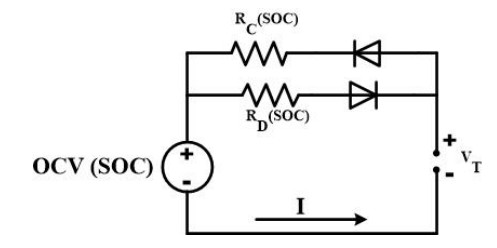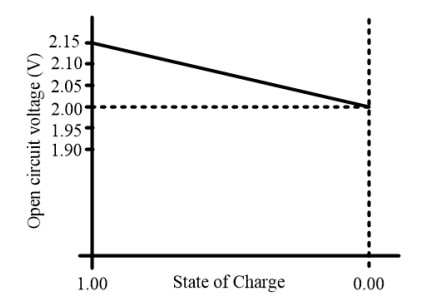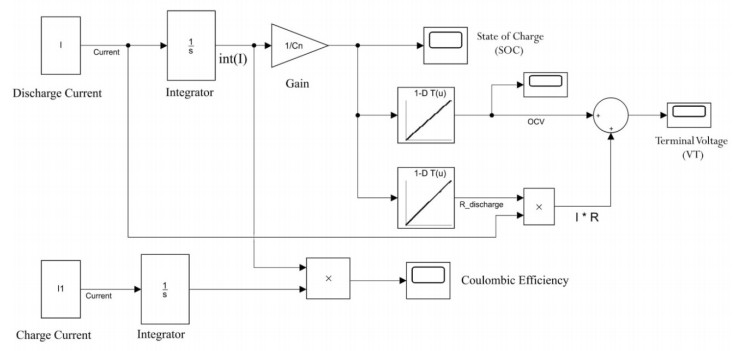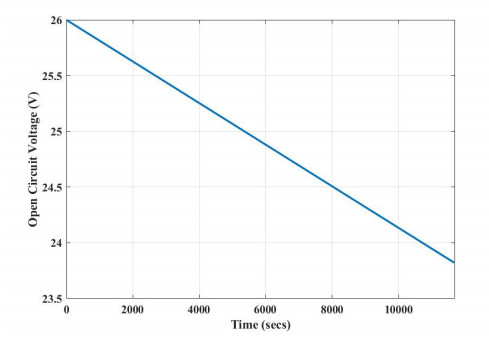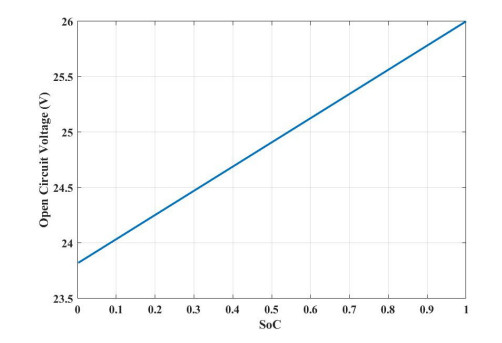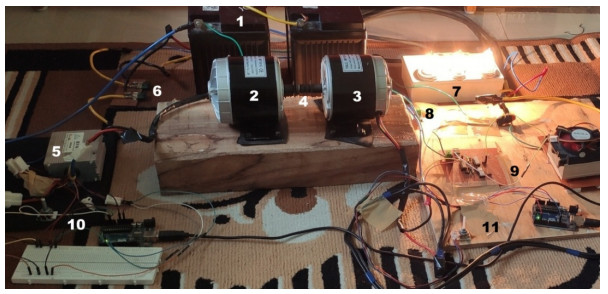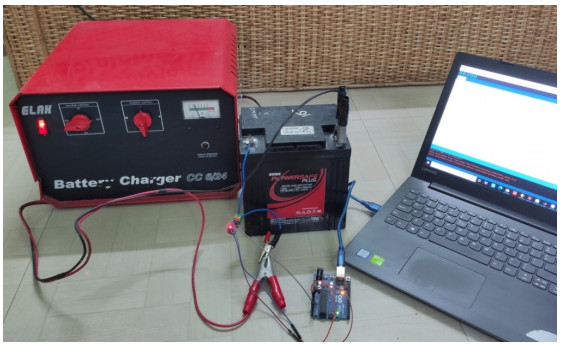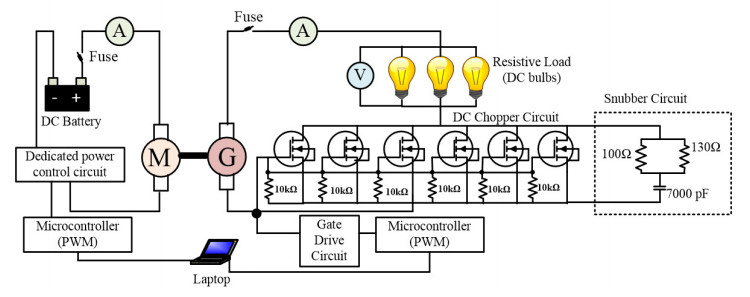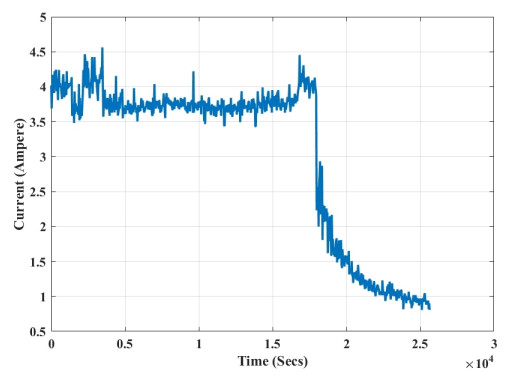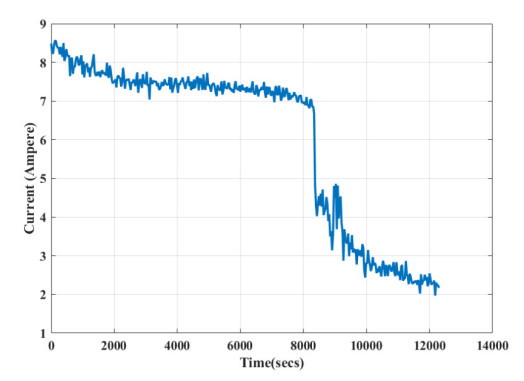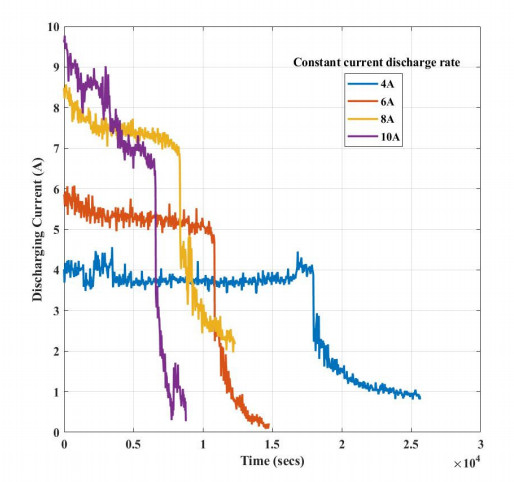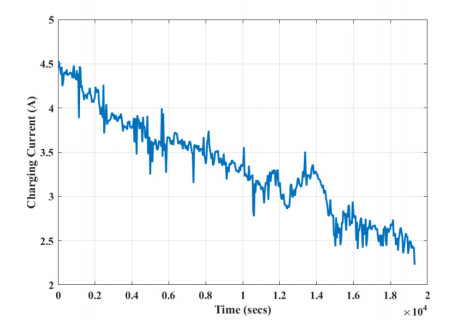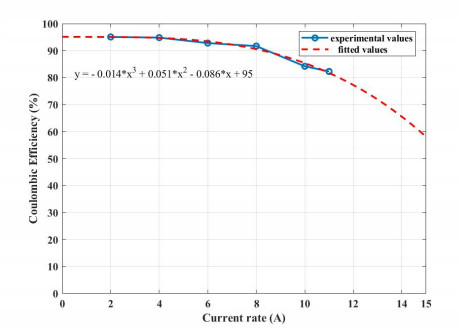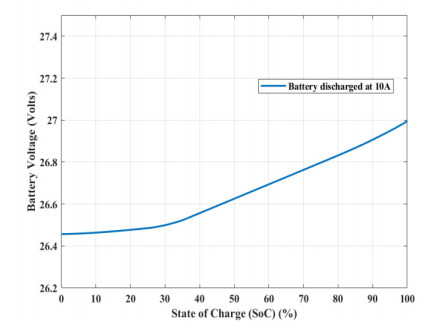1.
Introduction
The prime source of energy in electric vehicles (EVs) is undoubtedly a battery. An EV takes energy from a battery for all its system operations including the motors for propulsion. It is seen that range anxiety amongst users still act as a hindrance in acceptance of EVs amongst masses and enhancement of battery energy capacity is therefore an issue which needs attention in EV technology [1]. Most EVs still suffer from short range and high battery cost issues [2]. Efficient usage of the energy becomes essential especially in concepts like eco-routing navigation systems. Eco-routing navigation is a newer concept as far as the automotive technology is concerned. These systems predict the most energy-efficient route between two points of traverse which makes determination of battery parameters quites important [3]. Since energy consumption optimization is of prime concern these days, eco-routing can prove to be a sustainable solution when designing mobility models. The use of mobility models based on the eco-routing concept can help in extending range and improving the energy efficiency of electric vehicles [4]. Optimal battery usage also extends battery life. Battery life is mostly determined by the amount of energy that is being consumed by the device. When a battery is not being depleted, however, it can recover some of its lost energy, extending its life. Experts believe that EV battery performance in terms of driving range is critical in deciding the viability of the electric mobility system [5]. Although at present EVs mostly use Li-ion as their energy technology we shall limit our research to lead acid batteries. The efficiency of this battery type generally ranges from 70 to 90 percent [6]. This type fit perfectly where affordable and efficient transportation is required wherein speed and range issues are not major concerns, like in case of neighborhood electric vehicles (NEVs) [6].
Batteries exhibit non-linear characteristics and so prediction of parameters like state-of-charge (SoC) of batteries can become quite complicated. The accurate determination of battery parameters is almost a necessity for determining the range of an EV which in turn is vital for eco-routing navigation systems. Battery technology is now-a-days a subject where extensive research is being carried on. It is aimed at increasing the capacity, efficiency and also finding greener substitutes for conserving our environment. Although generous amount of information is present in literature, a universal way to determine the SoC in a battery has not yet been defined. Researchers use various battery models to duplicate vehicle performance using the battery sources. Electric vehicle is an area in which battery plays an essential role. No EV is complete without usage of battery sources. So, estimation of battery parameters is necessary for choosing the battery apt for that particular vehicle. Parameters like SOC and coulombic efficiency (CE) are required in calculation of range of the EV. They are also required for EV-based applications like eco-routing navigation where energy minimization is concerned. It is seen that in most cases, the battery parameters are calculated by automatic equipment available in the market. But those are costly and at times complex for use by students or researchers. Literature survey suggests that there are not many set-ups proposed on this type of work. Sharma et al. have published a set up for determining coulombic efficiency of battery in lead acid batteries in 2015 [7]. The shortcoming of that work is that the rate of discharge or charge cannot be fixed or determined by that method making it difficult to determine parameters accurately. The proposed method is a simple, user-friendly and cost effective for estimation of battery parameters. It consists of motor-generator coupled technique for recording the charging discharging cycles of batteries. In our case, lead acid batteries have been used for experimentation. The experimental set-up is simple, automated and allows discharge of batteries at various current rates. The load in the system is applied electronically which helps in maintaing a constant current during a particular cycle of operation. The charge-discharge cycle can be viewed in real-time and aids the determination of prime parameters like CE and SoC of the battery. The system has been used to charge and discharge the test battery over various cycles and have shown good efficiency and repeatibility. The coulombic efficiency obtained can then be used for determining the range of the EV. A highlight of this technique is that this proposed method and set-up can be used to test any type of battery like lithium ion battery and other energy storage systems and determine the consequent battery parameters. It is portable, provides good repeatibilty and can so be used by all, be it for research or for industry. In comparison to commercially available systems, this technique is comprehensible and easy to use. It is extremely cost effective as the circuitry used has simple and easily available components. Since the system has been built in quite a transparent way, it is easy for all to understand the working principle. This set-up helps in producing results which are real-time and therefore the current at any instant of time can be measured. Detection of battery parameters like efficiency is a significant aspect of all battery based applications, especially electric vehicle based applications. These parameters are required for range determination and energy consumption estimation of electric vehicles.
Electric Vehicles (EVs) play a pivotal role when sustainable mobility is concerned. In recent years, there has been an increasing use of EVs in the mobility of people and goods, and traditional ICEVs are getting replaced by EVs now. This evolution has several implications in the so-called tank-to-wheel process [8]. Newer technologies like Waves-to-wheels for port areas are also being researched upon [9]. As already mentioned, eco-routing navigation systems seem to be a viable solution in establishing sustainable mobility paradigms. This concept is based on the principle that people minimise their generalised costs of travel, mainly operationalised through a combination of the costs of travel and the time taken for travel [10]. The proposed work plays a pivotal role in development of eco-routing systems and estimation of energy consumption of EVs. Further development of this work shall include design and development of such a system which shall provide sustainable green energy solutions. The energy consumption estimation shall take into account factors like vehicle dynamics, aerodynamics, traffic flow, battery parameters and weather to accurately determine range of EVs and therefore improve energy efficiency of the vehicles.
2.
Literature survey
2.1. Lead acid batteries in electric vehicles
Lead-acid batteries are commonly recognised as the best power sources for EVs. The credit can be given to their fair qualities of being user-friendly, economical, adaptable and rechargeable. They are very low maintenance and best in terms of reliability and working capabilities. They can withstand slow, fast as well as overcharging. The specific energy and energy density of these batteries are 161 Wh.kg−1 and around 60 to 80 Wh.L−1 respectively [7]. The specific energy though is dependent on the usage of batteries and varies accordingly. Both high specific energy as well as high energy density are important features of EV batteries. The specific power of lead acid batteries is 75 to 100 W.kg−1 approximately [7]. They are also seen to exhibit a long life [11]. These types are capable of withstanding long term inactivity with or without solvent. These batteries have an ability to supply high surge currents which indicate a large power-to-weight ratio [12]. They can generate high currents and so is the most preferred choice of battery used in conventional vehicles for the starting, ignition, lighting (SLI) apart from few other electrical functions [13]. They are wet cell batteries with nominal cell voltage of approximately 2.1 Volts [14]. These types of batteries have quite low internal resistances. The chemical structure of a basic lead acid battery has been illustrated in Figure 1. The main demerits of a lead acid battery include its weight and insufficient energy storage for long range applications.
2.2. Importance of lead acid batteries in automotive industry
Lead acid batteries were the most preferred choice of power sources for EV usage. Early modern EVs like EV1 were powered by this type of batteries. The specific energy of this type of battery is much lower than fossil fuels and therefore is a far better choice of power for the environment. Though its use has diminished over the years due to newer technology, it is still the most commonly used battery at the research level. Our proposed work also comprises of experimentations using rechargeable lead acid batteries. Engine starter batteries and deep cycle batteries are two major categories of lead acid batteries. Deep cycle batteries are the preferred choice in many EVs because of their capability to provide continuous energy [15]. They can also be utilized as emergency backup in vehicles, although they require special charging procedures. Lead-acid batteries were previously used in the majority of EVs because they were cheap, easily available and technologically quite established. Also, charging and discharging of lead acid batteries led to emission of gases which were harmless if properly vented. This created a comfort on the conscience of EV users when impact on the environment was concerned. Deep-cycle lead batteries are costly and have a lifespan shorter than the automobile, generally requiring substitution after three years or so. The demerits of these batteries included the large weight of the batteries. Almost 25–50% of the EV mass was comprised of the battery weight alone. The efficacy of today's deep-cycle lead acid batteries is around 70 to 75%. Lead acid batteries are the leading component for the electric car industry today. It is because of their ability to provide the high surge currents needed for an automobile's starter motor making them a reliable power source. The amount of current a battery can provide depends on its internal resistance. Lead acid batteries have extremely low internal resistance and therefore even a relatively small battery can produce hundreds of watts for a few seconds. Lithium batteries have internal resistance around 10 times higher, so a lithium ion battery of the same voltage as a lead acid battery can only deliver just one-tenth of the peak current. Quick discharge from a battery causes heat and other effects which can cause parts of the battery to expand. Lead acid cells are pretty simple and rugged devices. In comparison, lithium ion batteries are not and are prone to explosion in extreme temperatures. They're almost fully recyclable, and the mass-production infrastructure is already in place. Another major factor or merit of lead acid batteries is the cost. They are much cheaper, about 25% of the cost of an equivalent lithium ion battery of the same capacity [15]. Charging is very simple; they tolerate float charging at a constant voltage so battery management is simpler. Finally, the cold temperature performance is a little better for lead acid batteries over all other types. Lithium-ion batteries are more expensive and much more fragile during charge-discharge.
2.3. Coulombic efficiency
The efficiency with which electrons move inside batteries either by charge or discharge is expressed as Coulombic efficiency (CE). It is also known as current efficiency or sometimes as faradaic efficiency [16]. In other words, it describes the movement of charges in a system thereby generating an electrochemical reaction. This efficiency is commonly determined using the coulomb counting method which provides crucial information for determining state-of-charge (SOC) of a battery, and thereby proves useful in determination of range and energy consumption of an EV [17]. CE is the ratio of the total charge removed from the battery by discharging to the total charge entering into the battery over a full cycle in mathematical terms [16]. Lithium-ion batteries have one of the best coulombic efficiency ratings, which can go upto 99% at a moderate charging rate. The efficiency of lead acid batteries is lower than Li-ion batteries and known to be at about 90 percent [2]. A high CE means a longer battery cycle life. Although the CE efficiency of lead-acid batteries is almost 10% lower than lithium-ion there are similarities. Batteries become warmer as they approach their full charge, and heat has an adverse effect on CE efficacy. A low efficiency can be a result of lower acceptance rates of charge or the increasing self discharge when the battery gets warm during its charging period. Temperature and age of the battery also plays a significant role in the efficiency of a battery. The best efficiency of all batteries is found in the 30 to 70 percent SOC range [2]. Determination of CE and SoC therefore becomes quite necessary while working with electric vehicles (EV) because range of EVs depends on batteries and a high CE implicates a long battery life.
3.
Battery modelling
Battery modelling is used as a foundation for design and management of batteries. The field of battery modelling comprises of two main areas, the estimation of battery performance and the battery design. The field of battery parameter characterization and performance evaluation has created far more awareness than its design part because of the reason that the battery performance is much more worked upon while the field of design is restricted to developers mostly [17]. Modelling of batteries is done to achieve various targets and prediction of vehicle performance is one of them. Such a model depends on prudent evaluation of performance data from a battery more than the internal chemistry of the battery itself. Battery performance mostly depends on its nominal voltage, capacity, temperature and also its age and the number of cycles the battery has been used for. Battery models can be categorically grouped as electromechanical models and as equivalent circuit models. While the former type is mostly used for designing of batteries, the latter is intended for research of dynamic and long-run simulation analyses [17]. Non-linearity during battery discharge makes its modelling quite intricate. Theoritically, in a discharge cycle the voltage remains constant but dropping to zero as soon as the battery is depleted. The capacity would therefore be constant as well and entire stored energy would be utilised. This scenario is very different when a real battery is considered. The discharge process leads to gradual drop in the voltage and also the effective capacity, espcecially for high discharge currents.
3.1. Simulated electrical circuit battery model
Estimation of behaviour of a system receiving energy from a battery requires an equivalent circuit or a model. Electrical circuit models (EECMs) simulate battery behaviour by combining electric elements such as a resistors, voltage source and capacitors. These models are useful in battery management systems and show high degree of accuracy when dynamically predicting battery parameters. The first task in simulation of battery performance is the construction of an equivalent circuit. A simple electrical circuit model has been mathematically simulated for evaluation of electric vehicle performance.
An equivalent electrical circuit model of a battery has been illustrated in Figure 2. In this figure, R0 is assumed to be the battery's internal resistance. The open circuit voltage is one of the prime quantities which need to be established. In lead acid batteries, Open Circuit Voltage (OCV) is found to be directly proportional to its State of Charge (SoC) [12]. The rate at which the battery is charged or discharged is found to have an impact on internal resistance of these batteries. RD(SOC) and RC(SOC) are the internal resistances while dicharging and charging of the battery respectively. VT is the terminal voltage of the battery. It is the voltage obtained when actual load is applied to the battery. Batteries contain small cells within to form a unit. The nominal voltage of one cell of a lead acid battery is 2.1 Volts and thus the open circuit voltage change with respect to the SoC occurs as shown in Figure 3. It can be clearly seen from the figure that open circuit voltage is approximately proportional to the battery SoC in lead acid batteries. The straight line in the diagram represents the actual decline in the OCV whereas the dotted line has been used only for reference. It shows that when the battery is fully discharged, the OCV of one cell of the battery is equivalent to 2.0 Volts. Considering that the SoC varies between 0(zero) when empty and 1 when full, the Eq (1) for OCV of a lead acid battery can be expressed as [12].
where n denotes the amount of cells present inside the battery. The internal resistance in most cases is constant for a specific battery but is observed to get affected by working temperatures and SoC at times.
Battery modelling helps to study the charging as well as the discharging pattern of a battery. The model that has been simulated consists of mathematical equations which are able to describe what is happening inside the battery. This model is based on a SOC-OCV relationship. Although there are various methods to calculate SOC, the most common method known as the Coulomb Counting method has been used here. The mathematical equations used in the model are as follows:
3.2. Simulation results
The simulated battery model was able to predict battery behaviour quite efficiently. It was observed that these results were in accordance with the results obtained from experimentation. The model was simulated in a MATLAB simulink environment and is illustrated in Figure 4.
The results for the open circuit voltage (OCV) and the State of Charge (SOC) of a lead acid battery have been displayed below in Figures 5 and 6 respectively. It can be seen that the model predicts battery behaviour quite well. The current discharge rate was fixed at 8 A and therefore the time required to fully discharge the battery was around 3.25 hours. This can be very well observed in Figure 5 where the OCV is seen to be depleting. The OCV is also seen to change from around 26 Volts when fully charged to 23.8 Volts at full depletion. Figure 6 depicts the SoC versus OCV curve during a discharge cycle in a lead acid battery. It is seen that the state of charge of the battery decreases from 1 (100%) to 0 (0%) when the OCV decreases in the cycle. Therefore, more the OCV higher will be the State of charge in the battery.
4.
Proposed method and design
In electric vehicles, the Ampere-hour method is the most widely used method for estimating battery state of charge [18]. The proposed method is based on a motor-generator coupling technique for determination of coulombic efficiency and thereby the battery behaviour. This technique shall allow the battery to be discharged at constant current rates by application of electric loads. The data for voltage as well as current can be extracted and recorded in real-time with the help of this technique. Lead acid batteries have been used for the experiment. A motor-generator set comprises of a combination of a motor and a generator that are mechanically connected with the help of a common shaft. It is a device used to convert electrical power from one form to another. This configuration converts electrical energy to a mechanical form. The rated PWM of both the motor and the motor acting as the generator must be the same in order for the coupling to work [19]. In this set-up, both the input power and the output power are electrical in nature but mechanical torque is present in power flow between the machines. This ensures electrical isolation between the two electrical systems [19]. The coupling set-up facilitates the application of electronic load to the system. Therefore, the battery in use can be discharged at various current rates.
4.1. Experimental set-up
The experimental set-up for the proposed method consists of two main segments; the motor segment and the generator segment. Two motors are connected end-to-end through a common shaft as depicted in Figure 7. The entire set-up consists of the battery source (24 V, 26 Ah) to be tested, resistive load (24 V DC bulbs) and current sensors. It also comprises of a power unit, a controller unit which consists of microcontroller, interfacing module and a laptop for data acquisition and evaluation. The discharging and charging currents are sampled and measured at every instant of time by Hall-effect current sensors that are connected in the circuit. During a particular cycle, the sensors detect the change in output voltage and send it to the microcontroller. The current can then be determined accordingly. The load is fixed with the help of power circuit connected to the generator.
Figure 8 shows the actual picture of the set-up used in this experimental method. The motor section and the generator section are electrically isolated. They have their separate power control units as well as microcontroller units. The components in Figure 8 have been tabulated in Table 1 in serial order.
The experimental set-up used for charging has been shown in Figure 9. The charger has been connected to a hall current sensor for determination of the accurate current profile while charging the battery. The block diagram of the set-up depicts the entire procedure taking place and is shown in Figure 10. Two 350 W PMDC motors are coupled to each other thereby acting as a motor-generator pair. Each of the motors is controlled separately by power converters and a microcontroller attached to them. The current in the circuit is sensed using hall current sensors. The battery follows a charge-discharge cycle to complete a set. The test is then repeated at different current rates by adjusting the load at the generator side.
4.2. Circuitry and working principle
The proposed system consists of two sections comprising of a motor and a motor acting as a generator connected through a common shaft. The specifications of all the circuitry involved in the experiment has been listed in Table 2. A battery source is connected to the motor which is to be tested. The speed of the PMDC motor is steered by pulse width modulation method (PWM). The motor controller comprises of the power MOSFETs as well the gate drive responsible for driving the motor. The voltage is to be applied between the gate and source terminal of the MOSFET for the generation of current flow in the drain. The energy produced by the motor when it runs is transferred to the generator through the shaft. The generator is connected to a resistive load and also its own power circuit through which it can be controlled. The application of electrical load occurs on the generator section of the system. On increasing the load, the more current is drawn from the battery, the DC bulbs acting as load gets turned on, thereby reducing the speed of the motor. For our experimentation, the battery is discharged at a constant current at every cycle. The amount of current drawn from the battery is continuously sensed through the hall current sensors connected in series with the battery and displayed in real-time through the microcontroller unit on a laptop.
5.
Calculations involved
The information of provided charge and consumed charge during a certain cycle of operation can aid in determining efficiency during that cycle. The Ah counting approach necessitates complete charge-discharge curve integration. It can be calculated by applying Eq (4) given below [7].
I(t) is the current during charge or discharge at time t. Ah counting method is achieved by piecewise approximation of the curve obtained through the above equation, and so hence the ampere hour can be simplified into the following summation as expressed in Eq (5).
The expression for Coulombic efficiency is as follows [7],
where Ahc is the rate of discharge and Ahs is the charge supplied to the load. The State-of-Charge of the battery is also a function of the current drawn or supplied to the battery and the time taken in doing so. The SoC is usually assumed to be one when the battery is fully charged and 0 when fully depleted. The SoC in discrete time can be mathematically derived by the given Eq (7):
where E[k+1] is the additional SoC which is dependent on the previous state E[k] SoC of the battery. Δtis the time interval between consecutive samples, i[k] is the current measured at that instant and Q is the total battery capacity. In this experiment, the current drawn from the battery has been measured continuously by using a hall sensor.
6.
Results and discussion
Using the proposed experimental set-up, several tests have been performed for the determination of the Coulombic efficiency and State-of-Charge of the test battery. One set of full charge and discharge completes one complete cycle. The battery is discharged with the help of a constant resistive electronic load thereby current is drawn from the battery at a constant current rate. Therefore, by changing the loads, the battery can be discharged at various current rates. Successful results have been obtained which help in estimating the coulombic efficiency of the power source.
Various rates for discharge were chosen for estimation of battery parameters for accurately. The discharge rates were 2 A, 4 A, 6 A, 8 A, 10 A and 11 A. The discharge cycles of few of the current rates have been illustrated. Figure 11 shows the discharge curve when the battery is discharged at a constant current rate of 4 A. It is seen that although a constant current method has been used in practical systems the current almost comes down to zero when the battery is fully discharged. The discharge curve when the battery is discharged at constant current rate of 8 A is represented in Figure 12. It can be clearly observed that this curve also shows a similar trend. The test battery is a 24 V/26 Ah lead acid battery and therefore drawing a current of 8A from it should discharge the battery in about 3.25 hours which is clearly seen from the curve.
The battery was continuously charged and discharged at different current rates for obtaining the results. A comparison has been drawn for the discharging current trend at the various discharge rates. The battery when discharged at the lowest rate of current takes the maximum time to get fully discharged or reach a zero SOC. It can be seen that the curve complies with the theoretical calculations for rated time of discharge for a specific cycle.For instance, in the curve depicted in Figure 13, a 6 A discharge takes around 15000 seconds which amounts to 4.16 hours. The theoretical calculation also leads to a similar discharge time because a 26 Ah battery discharging at a rate of 6 A will take 4.3 hours to completely discharge. Figure 13 shows a comparative analysis when the battery is discharged at different current rates. Battery is an energy storage device which has definite capacity named as Ampere hours (Ah). When it is discharged which means a load is connected to the battery, it starts drawing energy from the battery. Discharge at a constant load means that at full capacity, a constant load would provide constant current. As the charge depletes the terminal voltage of the battery drops in conformity with the characteristics of a lead acid battery and that result in the drop in current. Keeping constant current means the load will absorb constant current from the battery and lead to constant fall in the battery capacity. However, constant current is not maintained all along the course of a discharge cycle owing to the voltage drop which is an inherent property of lead acid batteries. Therefore, it can be seen from Figures 11, 12 and 13 that although the battery discharge was initiated at a constant current rate, the curves rapidly falls after a certain period of time due to the drop in potential.
The charge profile for a single cycle of operation is illustrated in Figure 14. At a rate of 0.1 C, the battery takes about 5 hours to get fully charged. The experiment was repeated at various other constant current rates, the curve for which has been shown in Figure 13. The Coulombic efficiency at different current rates were obtained manually and then projected in Figure 15 with the help of a curve fitting tool in Matlab. The curve shows a decreasing trend of efficiency with the increase in current. It shows that the efficiency of lead acid batteries is around 80–90%. Figure 16 shows the State-of-charge of the battery at a discharge rate of 10 A over a single cycle. Thus it can be concluded that the proposed method is simple, yields accurate results and can be used for the determination of coulombic efficiency as well as SoC of battery system. This is of great use to researchers in the field of EV applications because the efficiency and state of charge is a prime requirement when determination of range is taken into account. The range obtained can then be used for calculation of energy consumption during a trip while developing an eco-routing navigation system.
7.
Conclusions
A motor-generator coupling technique has been developed and implemented for the estimation of Coulombic efficiency of the batteries to be used in a test EV. The main objective of this research work is the technique for estimation of battery parameters including Coulombic Efficiency and State of Charge of the test batteries. A simplified battery model has also been simulated and modelling was performed to show a comparative analysis between theoretical and practically obtained data. This process can be used to test any type of battery source before using it for a specific application. A lead acid battery of 24 Volts/26 Ah was put to test by continuously charging and discharging it over various cycles. The tests were run by application of varied loads at constant different current rates. In this process, however only the physical aspects of batteries have been considered during experimentation. External factors have been ignored here. Results obtained were satisfactory as it can be observed that they are in accordance with theoretical data available. The data for discharge as well as charge can be observed and recorded in real-time which acts as an added feature of the technique. It was seen that for instance, discharge at a constant current rate of 8 A took around 3.33 hours which coincides with theory when a 26 Ah battery is discharged. The Coulomb counting method has been used for the determination of Coulombic efficiency as well the SoC of the battery. The results obtained are considerable and indicates that the system that has been proposed can be effectively used for estimation and analysis of battery parameters including Coulombic efficiency. The Coulombic Efficiency is seen to degrade with increasing amount of charge-discharge cycles. An efficiency as high as 90% to 92% can be achieved if the battery is discharged at moderate or low current rates. CE mostly depends on rate of discharge current. The experimental set-up developed is in a crude form and so in further works it shall be improvised so that an even more efficient system can be achieved. Further works also include the use of Coulombic Efficiency in calculation of range which is an integral part when energy consumption or finding an eco-route where electric vehicles is concerned.
Acknowledgment
We would like to extend our sincere gratitude to Visvesvaraya Ph.D. Scheme for Electronics and IT, Ministry of Electronics and Information Technology, Government of India, for supporting this research work.
Conflict of interest
The authors hereby declare that there is no conflict of interest regarding any work reported in this manuscript.
Author contributions
The research work has been carried out by Kritanjali Das and has been fully supervised by Santanu Sharma. Both the authors involved in this work do hereby approve the publication of this manuscript.
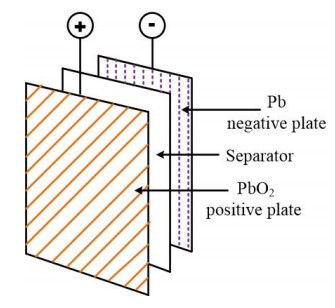









 DownLoad:
DownLoad:
